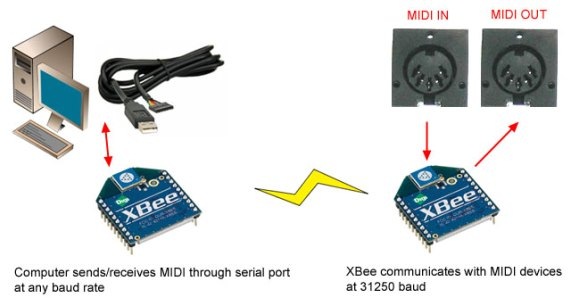Interested in experimenting with MIDI, minus the wires? Why not try a DIY hack yourself? Limor Fried aka Lady Ada of Adafruit Industries has posted a detailed tutorial on transmitting MIDI over the inexpensive and relatively friendly XBee wireless module.
It’s a bit of a hack – you force the XBee to communicate at MIDI baud rate, and on Windows, at least, you have to fool the OS into using MIDI’s non-standard baud rate for serial communications. But it seems to work. That’s where you come in: Limor’s got some folks testing this, but we could use some additional real-world tests and a “port” of the instructions to Mac OS and Linux. (I’ll be testing, too, once I get my hands on some spare XBees.)
Tutorial: Using XBees to create a wireless bi-directional MIDI link [ladyada.net/make]
HOW TO – Using XBees to create a wireless bi-directional MIDI link [adafruit blog]
Ingredient list:
- XBee module
- Adafruit’s own handy XBee Adapter Kit (an adapter board that makes it easier to add the wireless module to your own projects)
- Parts for making the MIDI adapter: MIDI connectors, optocoupler, hex inverter
- A computer (Limor runs Windows, but any OS should work)
- Some MIDI gear (see: hardware manufactured from the mid-1980s to now)
How does this compare to commercially-available wireless MIDI adapters? Honestly, I have no idea – that’s where we could use some real-world tests. (Yeah, I know – I’m really helpful. But then, there’s still a compelling argument for wires in many situations.) My guess is, if you’re serious about wireless MIDI, you may want to consider other alternatives.
If you’re serious about wireless, in fact, you may want to look beyond MIDI. Brian Kerr, who brought his own wireless controller to a recent Handmade Music night, chose OpenSoundControl after unsuccessfully testing MIDI. The problem with OSC, of course, is that you really need MIDI on the other end for almost all hardware (like Limor’s own x0xb0x 303 clone). OSC is a better choice if you’re building your own project – you can always convert back to MIDI on the other end, but you have the convenience of OSC over wireless and can use OSC natively with software that supports it. (Visual software, tools like Max, Processing, and SuperCollider, and – I really do believe – soon, music software will work.)
But then again, this is a fantastic way to experiment with the XBee and to try some fun stuff with MIDI gear you’ve already got hanging around – and may be just fine for some applications. I’m eager to hear how it goes. More on wireless control and projects soon – stay tuned. Thanks for the great work on this, Limor!
